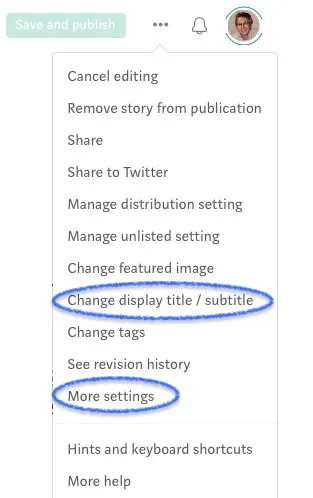
I’m a systems analyst with a Master’s Degree, which is why I tend to discover details of useful features that others might miss. I’ll discuss these essential details that you can take advantage of to improve readership and earnings with your articles on the Medium platform.
Many writers on Medium just let it default and they don’t examine the results to see how it looks on their profile listing.
Subtitle: The subtitle is like a summary. It appears under the title on your profile listing as well as any other locations where Medium showcases your article. That includes their blog and emails.
If you ever change the subtitle on a story, you also need to update the text that appears in the listing on your profile page. Many people miss that. You do that by clicking the three dots on top and selecting “Change display title/subtitle” from the menu.
Description: The description is used for SEO purposes by Google and other search engines to display under your title in the SERPs (search results page).
If you don’t specify a description, Medium will use to the first sentence in your article but may truncate it if it’s too long. In some cases, it’s helpful to specify an alternate description. Two things you should consider:
While editing an article, click the three dots at the top and select “More Settings.” Then scroll down to the “SEO Settings” section.
Here you can enter or change the “SEO Description” that Google sometimes uses in the SERPs. That helps attract Google traffic.
Of course, we don’t get paid for organic views. However, once in a while, someone will pay to subscribe. Without a doubt, we get paid retroactively if a reader subscribes within a few days.
I noticed sometimes I get paid on days when I have no views on a particular article. So I assume that’s when someone subscribed who had recently read it.
While editing an article, click the three dots at the top to open a menu of options as shown here.

Click on “Change display title/subtitle” to override the Title and Subtitle.
This is what’s displayed as the title and subtitle everywhere your article is showcased on Medium.
It’s important to remember that if you ever change the title or subtitle in your article, you need to change it here too.
The SEO Description is changed under the “More settings” option.
As I mentioned, the subtitle is the summary displayed under the title in your profile. It’s used in previews posted to social media too. Subtitles are limited to 140 characters.
I discovered a problem with subtitles, however. They don’t always show up in the profile listing. In some cases, they are truncated — even if you keep it short. It seems it’s dependent on the device. The display varies if it’s on a desktop, smartphone, or tablet. So if you can, check that on each of these devices so you know how your listings will look.
Since the description is the text that Google and other search engines display in the search listings, it’s crucial to write one that is not truncated. Medium lets you go up to 200 characters, but Google usually truncates this to 160 and even as little as 120 characters. Keep that in mind, when you write your description.
Both the subtitle and description are meant to give the reader a quick understanding of what to expect. But they serve somewhat different purposes. As you already know, the subtitle appears under the title. Therefore it should be short and to the point.
The description is more important. Don’t let Medium default it to your first sentence. Write a custom description, as I explained earlier. I usually try to keep it under 120 characters, so Google doesn’t truncate it. If necessary, make it clear what the article is about by starting with any of the following phrases:
This method of introducing the explanation will help keep the potential reader focused on the topic of your discussion.
Be careful what you say in your first sentence when commenting. That is used as the headline in the listing of your responses displayed in your profile.
Sometimes the second sentence is shown below the headline, but I noticed that’s not consistent. In some cases, there is no text under the headline. Just your first sentence shows up.
Therefore you want that to be meaningful so that people find it interesting enough to click to it and read the entire comment. If your comment is noteworthy, people will be enticed to go to your profile to learn more about you. You may get additional followers that way.
Check it out yourself to see what shows up on your profile. Click the “Responses” tab on your profile to display all the comments you’ve been making in other people’s articles.
If your comment is noteworthy, people will be enticed to go to your profile to learn more about you.
You can only do this BEFORE you publish a draft, and you can only change the story name in the URL. It includes a unique post sequence number and the name of the publication (if you post to one). Those cannot be changed.
To get to the URL field, click the three dots while in edit mode, and select “Customize story link” from the menu.
Change “Automatic” to “Custom,” and the field will appear. Type in whatever you want. I like to shorten the link as the full title might make the URL way too long. I like to remove unnecessary words in the URL.
It helps Google to index your article better when the vital keywords are in the URL without extra fluff. Some titles might have the same word twice, and it’s best to eliminate duplication in the URL.
Remember that you can only specify the URL before you publish. You can’t change it later—that’s to avoid creating dead links wherever your article might have been shared.
All these suggestions are beneficial for success on Medium. I always consider them when writing or updating articles.